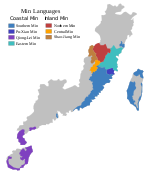| Manjiang | |
|---|---|
| 蠻講, 蠻話 | |
| Native to | China |
| Region | southeastern Zhejiang |
| Native speakers | 500,000 (2012) |
| Language family | Sino-Tibetan |
| Early forms | Proto-Sino-Tibetan |
| Language codes | |
| ISO 639-3 | – |
| Glottolog | None |
| Linguasphere | 79-AAA-ia |
Manjiang (simplified Chinese: 蛮讲; traditional Chinese: 蠻講; pinyin: Mánjiǎng), also known as Manhua (simplified Chinese: 蛮话; traditional Chinese: 蠻話; pinyin: Mánhuà; lit. 'Man speech'), is an Eastern Min dialect spoken mainly in Taishun and Cangnan Counties in Wenzhou, as well as parts of Qingyuan County in Lishui, in southeastern Zhejiang province.
As a dialect of Eastern Min, Manjiang is very distant from major Chinese varieties such as Mandarin and Cantonese, and displays very significant elements of a substratal indigenous language, perhaps belonging to the Austroasiatic or Tai–Kadai language families.
Notes
- Min is believed to have split from Old Chinese, rather than Middle Chinese like other varieties of Chinese.
References
- ^ Cao 2012, p. 205.
- Mei, Tsu-lin (1970), "Tones and prosody in Middle Chinese and the origin of the rising tone", Harvard Journal of Asiatic Studies, 30: 86–110, doi:10.2307/2718766, JSTOR 2718766
- Pulleyblank, Edwin G. (1984), Middle Chinese: A study in Historical Phonology, Vancouver: University of British Columbia Press, p. 3, ISBN 978-0-7748-0192-8
- Hammarström, Harald; Forkel, Robert; Haspelmath, Martin; Bank, Sebastian (2023-07-10). "Glottolog 4.8 - Min". Glottolog. Leipzig: Max Planck Institute for Evolutionary Anthropology. doi:10.5281/zenodo.7398962. Archived from the original on 2023-10-13. Retrieved 2023-10-13.
Sources
- Cao, Zhiyun (2012). "B2-10 Zhèjiāng Shěng de Hànyǔ fāngyán" B2—10 浙江省的汉语方言 [B2-10: Chinese Dialects in Zhejiang Province]. Zhōngguó yǔyán dìtú jí 中国语言地图集 [Language Atlas of China] (in Chinese). Vol. 汉语方言卷 (2nd ed.). Beijing: Commercial Press. pp. 204–208. ISBN 978-7-100-07054-6.
| Sino-Tibetan branches | |||||
|---|---|---|---|---|---|
| Western Himalayas (Himachal, Uttarakhand, Nepal, Sikkim) |
|  | |||
| Eastern Himalayas (Tibet, Bhutan, Arunachal) | |||||
| Myanmar and Indo- Burmese border |
| ||||
| East and Southeast Asia |
| ||||
| Dubious (possible isolates) (Arunachal) |
| ||||
| Proposed groupings | |||||
| Proto-languages | |||||
| Italics indicates single languages that are also considered to be separate branches. | |||||
| Min Chinese | ||||||||||||||||||||||||||||||||||
|---|---|---|---|---|---|---|---|---|---|---|---|---|---|---|---|---|---|---|---|---|---|---|---|---|---|---|---|---|---|---|---|---|---|---|
| ||||||||||||||||||||||||||||||||||
| ||||||||||||||||||||||||||||||||||
| ||||||||||||||||||||||||||||||||||
| Chinese language | ||||||||||||||||||||||||||||||||||||||||||||||||||||||||||||||||||||||||||||||||
|---|---|---|---|---|---|---|---|---|---|---|---|---|---|---|---|---|---|---|---|---|---|---|---|---|---|---|---|---|---|---|---|---|---|---|---|---|---|---|---|---|---|---|---|---|---|---|---|---|---|---|---|---|---|---|---|---|---|---|---|---|---|---|---|---|---|---|---|---|---|---|---|---|---|---|---|---|---|---|---|---|
| Sinitic languages | ||||||||||||||||||||||||||||||||||||||||||||||||||||||||||||||||||||||||||||||||
| Major groups |
|  | ||||||||||||||||||||||||||||||||||||||||||||||||||||||||||||||||||||||||||||||
| Standard forms | ||||||||||||||||||||||||||||||||||||||||||||||||||||||||||||||||||||||||||||||||
| Phonology | ||||||||||||||||||||||||||||||||||||||||||||||||||||||||||||||||||||||||||||||||
| Grammar | ||||||||||||||||||||||||||||||||||||||||||||||||||||||||||||||||||||||||||||||||
| Idioms | ||||||||||||||||||||||||||||||||||||||||||||||||||||||||||||||||||||||||||||||||
| Input | ||||||||||||||||||||||||||||||||||||||||||||||||||||||||||||||||||||||||||||||||
| History | ||||||||||||||||||||||||||||||||||||||||||||||||||||||||||||||||||||||||||||||||
| Literary forms |
| |||||||||||||||||||||||||||||||||||||||||||||||||||||||||||||||||||||||||||||||
| Scripts |
| |||||||||||||||||||||||||||||||||||||||||||||||||||||||||||||||||||||||||||||||
This China-related article is a stub. You can help Misplaced Pages by expanding it. |
This Sino-Tibetan languages-related article is a stub. You can help Misplaced Pages by expanding it. |
